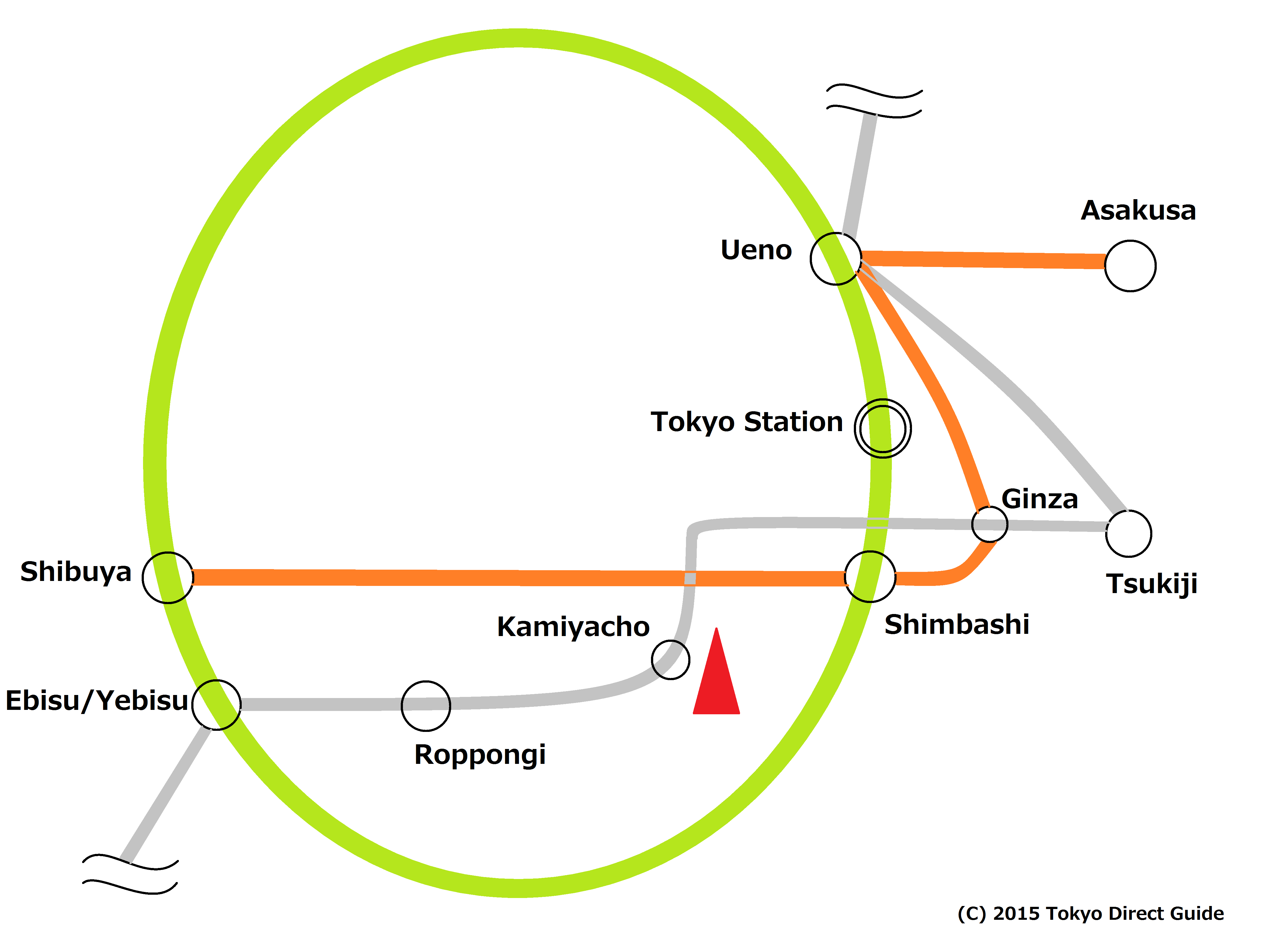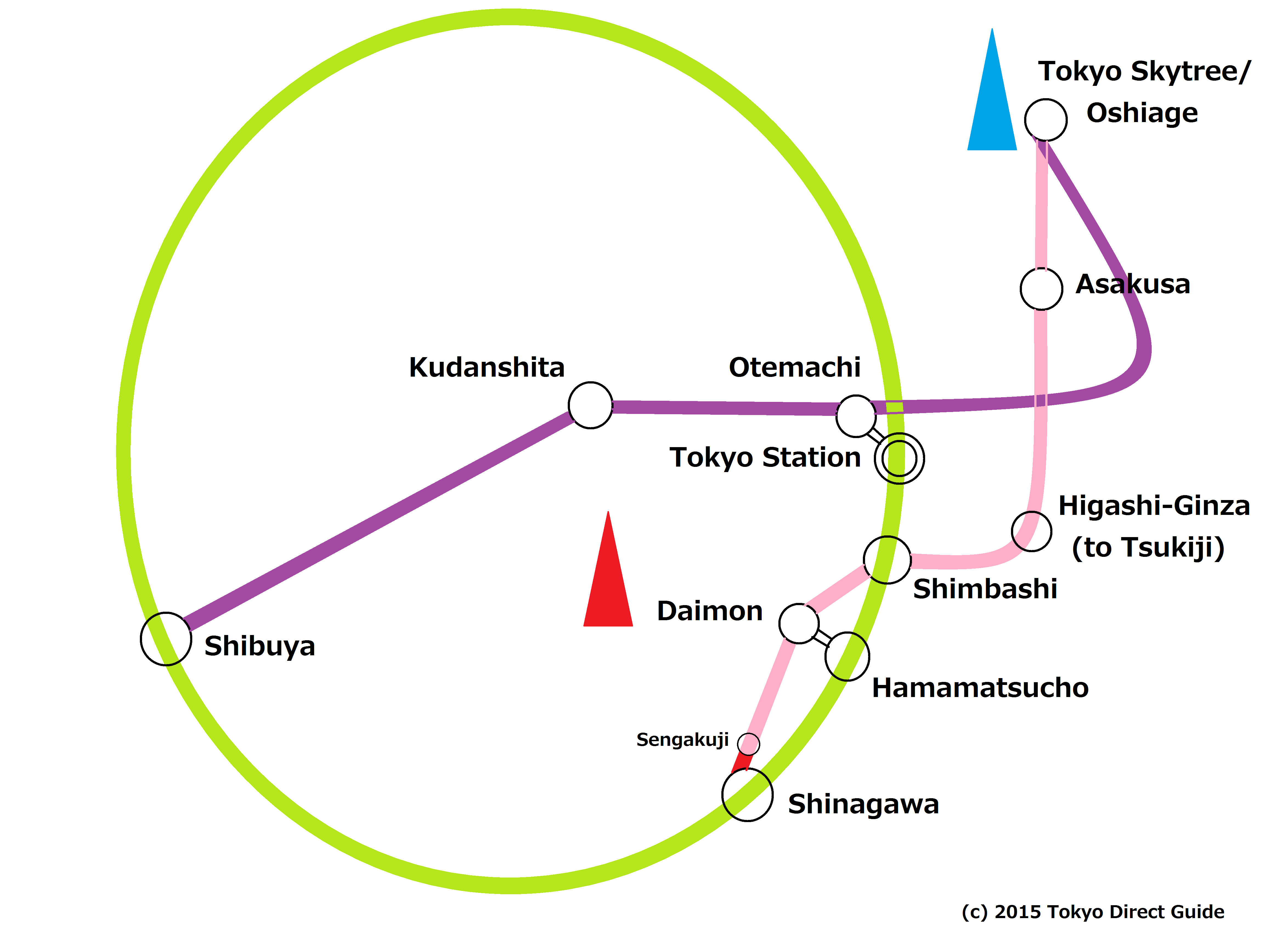The Easiest Subway Maps of Tokyo
Tokyo's subway route map is extremely complicated as well as JR Trains on the ground. Seeing is believing.

There are 13 subway lines and 286 subway stations in Tokyo. Actually, many international travelers get lost in this maze of the metro system.
You need to take a subway to visit some of Tokyo's Must-Sees, including Asakusa, Tsukiji Market, Roppongi, etc, because the nearest stations of these places are not JR stations but subway stations.
Talking from a local's point of view, you don't need to stare at the entire of the maps. Let's simplify and reorganize the maps to understand Tokyo. I picked up some subway lines leading to Tokyo's tourist attractions.
Print them out and keep this page for your better travel! (All Free but Personal use only.)
cf: Internet Access in Japan
Ginza Line and Hibiya Line
*I draw JR Yamanote Line in all these subway maps. To learn Tokyo's maps quickly, learn this loop line from here.
Ginza Line
Ginza Line is the first subway in Japan; People connected all the important places in Tokyo when they were able to draw a subway route freely.
It goes between Shibuya and Asakusa, through the very center of Tokyo City such as Omotesando (Harajuku area,) Ginza, Nihon-bashi, Ueno, etc.
Ginza Line is the best way to go to Asakusa.
Hibiya Line
Hibiya Line is a major way to go to Tsukiji Market and Roppongi. The major stations to get on a Hibiya Line train are Ebisu, the next station to Shibuya, Ueno and Akihabara. They are all on JR Yamanote Line.
Kamiyacho is one of the nearest stations to Tokyo Tower; It is a 7 minutes walk.
Tip: If you go opposite to Tokyo City from Ebisu, Hibiya Line directly goes through Toyoko Line and Minato-Mirai Line. It takes you to China Town and Minato-Mirai district, which are very cool bay side area in Yokohama.
Hanzomon Line and Asakusa Line
Hanzomon Line
Hanzomon Line has many important stations, and it radically became even more important because of Tokyo Skytree.
The major stations to get a Hanzomon train are Shibuya and Otemachi, which is connected to Tokyo Station.
Kudanshita is the nearest station of Chidorigafuchi/Imperial Palace, which is one of the best cherry blossom spots in Tokyo. (You can go there by Shinjuku Subway Line or Tozai Subway Line, too.)
Asakusa Line
Asakusa Line is another subway which is getting more and more important. It is directly connected with Keikyu Line, which is a major way to go to/from Haneda Airport.
You get on Keikyu Line at Shinagawa Station, and you will be on Asakusa subway line after Sengakuji station. Asakusa Line takes you to Higashi-Ginza, which is one of the nearest stations of Tsukiji Market, Nihon-bashi, Asakusa and Oshiage/Tokyo Skytree at last.
JR Hamamatsucho and Daimon subway station are near Tokyo Tower; 15 minutes walk from Hamamatsucho, 10 minutes walk from Daimon.
Tip: If you are staying at a place along Asakusa Subway Line, you have a good access to Narita Airport. There are rapid trains called Access Express, which directly connect to Keisei Sky Access Line, and rapid trains via Keisei's main line to Narita Airport.
It takes 75 minutes from Shinagawa, 65 minutes from Shimbashi, 64 minutes from Higashi-Ginza, 61 minutes from Nihon-bashi, 53 minutes from Asakusa and 49 minutes from Oshiage by Access Express, and costs less than Keisei Skyliner.
I did not write about Access Express in How to get to Tokyo City from Narita Airport to avoid confusion - It has several types. But if you are in a district alond Asakusa Line, it will make your trip more comfortable.
Ask a concierge what time you can take the train and how many minuties it takes to the airport.
Oedo Line
Oedo Line
Oedo Line is the newest subway in Tokyo; The route map is designed for convenience of people, including travelers.
It is a loop line - almost, actually - from Shinjuku. It is another major way to go to Roppongi and Tsukiji Shijo(=Market). It also stops at Ryogoku, where there are the sumo wrestling stadium and Yedo Tokyo Museum.
"Tocho-Mae" means, "in front of Tokyo Metropolitan Government." The building has a free observatory. It is a 10 minutes walk from Shinjuku Station.
Akabane-bashi is the nearest station to Tokyo Tower; It is a 5 minutes walk.
Tip: Oedo Line is the newest subway in Tokyo; It means it runs the deepest. As a result, the escalators to/from the platforms are very long.
If you are taking Oedo Line for a business conference or something that you cannot be late for, take it early!
If you are going to Tokyo Tower, except JR Hamamatsucho, Daimon, Kamiyacho, and Akabane-bashi, it is a 6 minutes walk from Onarimon Station of Mita Subway Line. You can get a Mita line train at Otemachi (connected to Tokyo Station,) Meguro, Sugamo, Suido-bashi, etc.
How to Get to Tokyo Tower by train - the simplest explanations & maps
Links to the Complete, Official Subway Maps
If your distination is not on these maps, see the JR Train Map as well.
You can download the complete subway maps from the following links. Get BOTH maps.
http://www.tokyometro.jp/lang_en/station/index.html (English, Spanish, French, German, Chinese, Korean and Thai)
http://www.kotsu.metro.tokyo.jp/eng/services/sub_map.html (English, Chinese and Korean)
Travel Tip - Not to get lost
- Look up which subway to take to your destination BEFORE you go sightseeing. Every page of Tokyo's Must See & Do and Blog Tokyo Direct Diary has information about how to get to the place by train and subway.
- Remember the color of the subway line you take. Every subway has its color and all the subway maps, including my maps, adopt them. For example, Ginza Line's color is orange. In the stations, you will find G mark of Ginza Line. Just follow the color and initial of the subway line, and you will find the right platform.
Travel Tip - When you get lost
- Check which station you are in and which subway you took.
- If you have a lot of time, think of getting back to the nearest hub station such as Tokyo, Shinjuku, or a JR Yamanote Line Station. Calm down and look up the right way to go to your destination.
- If you got a wrong subway, check which is the right subway to your destination. Find a station where the two lines are crossing. If it does not work, give it up and go back.
Want to see MORE destinations?
See the Easiest JR Train Map as well as subways, and you will find most of Tokyo's tourist attractions and access to/from Narita and Haneda Airport.
Talking about Odaiba, the bay side district, see this.
Dig Tokyo here - https://tokyo-direct-guide.com/blog/
Don't make an unnecessary effort to learn all the 285 subway stations of the 13 lines.
Focus on your destination with the Easiest Subway Maps, and you can travel freely like a local.
Have a nice trip!
Tickets
Coming soon!




